Mostrar el registro sencillo del ítem
dc.contributor.author
O'Meara, Rachel N.

dc.contributor.author
Dirks, Wendy
dc.contributor.author
Martinelli, Agustín Guillermo

dc.date.available
2020-01-08T21:49:03Z
dc.date.issued
2018-05
dc.identifier.citation
O'Meara, Rachel N.; Dirks, Wendy; Martinelli, Agustín Guillermo; Enamel formation and growth in non-mammalian cynodonts; The Royal Society; Royal Society Open Science; 5; 5; 5-2018; 1-27
dc.identifier.issn
2054-5703
dc.identifier.uri
http://hdl.handle.net/11336/94078
dc.description.abstract
The early evolution of mammals is associated with the linked evolutionary origin of diphyodont tooth replacement, rapid juvenile growth and determinate adult growth. However, specific relationships among these characters during non-mammalian cynodont evolution require further exploration. Here, polarized light microscopy revealed incremental lines, resembling daily laminations of extant mammals, in histological sections of enamel in eight non-mammalian cynodont species. In the more basal non-probainognathian group, enamel extends extremely rapidly from cusp to cervix. By contrast, the enamel of mammaliamorphs is gradually accreted, with slow rates of crown extension, more typical of the majority of non-hypsodont crown mammals. These results are consistent with the reduction in dental replacement rate across the non-mammalian cynodont lineage, with greater rates of crown extension required in most non-probainognathians, and slower crown extension rates permitted in mammaliamorphs, which have reduced patterns of dental replacement in comparison with many non-probainognathians. The evolution of mammal-like growth patterns, with faster juvenile growth and more abruptly terminating adult growth, is linked with this reduction in dental replacement rates and may provide an additional explanation for the observed pattern in enamel growth rates. It is possible that the reduction in enamel extension rates in mammaliamorphs reflects an underlying reduction in skeletal growth rates at the time of postcanine formation, due to a more abruptly terminating pattern of adult growth in these more mammal-like, crownward species.
dc.format
application/pdf
dc.language.iso
eng
dc.publisher
The Royal Society

dc.rights
info:eu-repo/semantics/openAccess
dc.rights.uri
https://creativecommons.org/licenses/by/2.5/ar/
dc.subject
CYNODONT
dc.subject
DENTAL HISTOLOGY
dc.subject
ENAMEL DEVELOPMENT
dc.subject
ENAMEL INCREMENT
dc.subject
MAMMALIAFORM
dc.subject
MAMMALIAMORPH
dc.subject.classification
Paleontología

dc.subject.classification
Ciencias de la Tierra y relacionadas con el Medio Ambiente

dc.subject.classification
CIENCIAS NATURALES Y EXACTAS

dc.title
Enamel formation and growth in non-mammalian cynodonts
dc.type
info:eu-repo/semantics/article
dc.type
info:ar-repo/semantics/artículo
dc.type
info:eu-repo/semantics/publishedVersion
dc.date.updated
2019-10-16T19:29:33Z
dc.journal.volume
5
dc.journal.number
5
dc.journal.pagination
1-27
dc.journal.pais
Reino Unido

dc.description.fil
Fil: O'Meara, Rachel N.. University of Cambridge; Reino Unido
dc.description.fil
Fil: Dirks, Wendy. University of Durham; Reino Unido
dc.description.fil
Fil: Martinelli, Agustín Guillermo. Consejo Nacional de Investigaciones Científicas y Técnicas. Oficina de Coordinación Administrativa Parque Centenario. Museo Argentino de Ciencias Naturales “Bernardino Rivadavia”; Argentina
dc.journal.title
Royal Society Open Science
dc.relation.alternativeid
info:eu-repo/semantics/altIdentifier/url/http://rsos.royalsocietypublishing.org/lookup/doi/10.1098/rsos.172293
dc.relation.alternativeid
info:eu-repo/semantics/altIdentifier/doi/http://dx.doi.org/10.1098/rsos.172293
Archivos asociados
